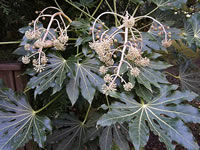How to Grow and Care for Japanese Aralias
Fatsia japonica
       
Japanese Aralias are one of the easiest of all shade garden or house plants to grow and care for.
They have large (up to 16"), dark green, palmate leaves and form tropical looking, evergreen shrubs that can grow
up to 6-8 feet tall and 6 feet wide,
but are easily limited to a height of 2-4 feet with pruning.
Mature Fatsias produce rounded clusters of small white flowers on white stalks in the fall,
which are followed by small, fleshy black fruit.
Fatsia Japonica plants are only hardy in USDA zones 8-11. Elsewhere they are grown in containers
and moved indoors for the winter, or they are grown as year-round house plants.
Gold and white variegated forms are available, but they are slightly more difficult to grow.
|
 |
Growing Japanese Aralias in the Garden
In the garden, Japanese Aralias should be grown in a protected area with partial to full shade except in northern zones where they will appreciate a little morning sun. Hot summer sun will quickly burn the foliage. Fatsias should be planted in slightly acidic, moist but well-drained soil that has been enriched with a generous amount of compost at planting time.
Water regularly and thoroughly to keep the soil evenly moist during the summer, but watering should be reduced during their dormant, winter months.
Provide a heavy mulch during the winter in areas where their hardiness may be marginal.
Feed Fatsias monthly when they are actively growing, using a complete, balanced fertilizer.
Take precautions to protect these plants from slugs and snails.
|
|
Growing Japanese Aralias as House Plants
Fatsias seldom bloom when they are grown indoors.
When grown in planters, their size increases proportionate to the size of the pot.
Indoors, Japanese Aralias should be placed in a spot where they will receive bright, indirect light.
The ideal indoor growing temperatures are 65°-75° during the day and 50°-60° at night.
They should be planted in a rich, fast draining, commercial potting mix
and kept evenly moist from spring through fall, but slightly drier in winter.
Never allow the soil to become soggy! Over-watering can quickly cause root rot.
Feed every 2 weeks while actively growing using a half strength dilution of a balanced, soluble fertilizer.
Fatsias can be kept small by cutting them back hard in the spring.
Pinch back new growing tips to induce bushiness.
Wash the leaves and mist regularly to keep your plant happy.
Japanese Aralias require a dormant period in the winter, when they will benefit from cooler temperatures of 50°-55°. Allow the soil to dry out slightly before watering during this time.
Propagating Fatsia Plants and Growing them from Seed
Japanese Aralias can be propagated with stem cuttings taken
from late spring up until mid-summer.
Sucker growths can easily be dug up and transplanted elsewhere.
In areas where they are hardy, Fatsia seeds can be sown
directly into the garden in the spring or fall.
Sow seeds indoors at any time of the year. Maintain a temperature within the growing medium of 70° to 75° until germination, which will take 15-20 days. |
|
Japanese Aralia
Fatsia japonica
 |
|
|
|
|
Search The Garden Helper:


